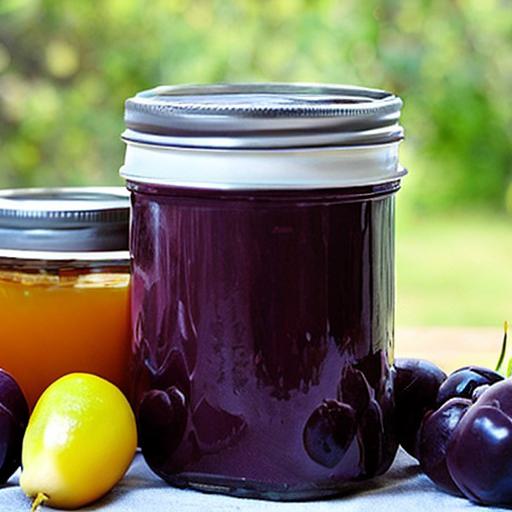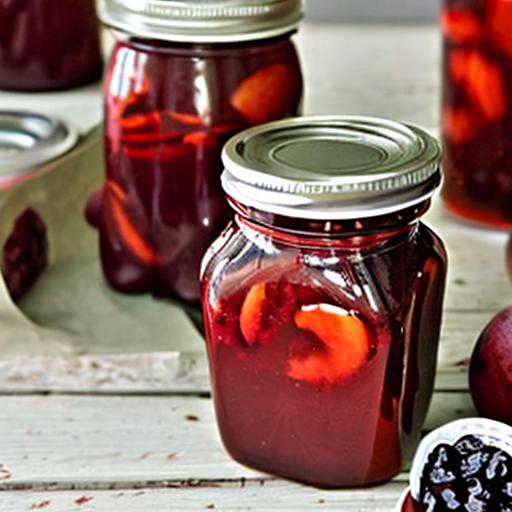Canning prune juice is a great way to preserve the delicious flavor and nutritional benefits of prunes for year-round enjoyment. Prune juice is not only a tasty beverage but also a good source of dietary fiber, vitamins, and minerals. Follow this ultimate guide to learn how to can prune juice and have a supply of homemade, preservative-free prune juice at your disposal.
Ingredients and Equipment:
- Fresh, ripe prunes
- Water
- Sugar (optional, for sweetening)
- Lemon juice (optional, for flavor)
- Canning jars with lids and bands
- Water bath canner or pressure canner
- Canning funnel
- Jar lifter
- Ladle
- Large pot for cooking

Step-by-Step Instructions:
1. Preparation:
- Wash and sterilize your canning jars, lids, and bands by either running them through a dishwasher cycle or immersing them in boiling water for a few minutes. Keep them hot until you’re ready to fill them.
- Wash and pit the prunes, then chop them into small pieces.
2. Prepare the Juice:
- In a large pot, combine the chopped prunes with enough water to cover them completely.
- Simmer the prunes over low to medium heat, stirring occasionally, for about 20-30 minutes or until they become soft and mushy.
- If you prefer sweetened prune juice, add sugar to taste during the cooking process. You can also add a splash of lemon juice for extra flavor.
3. Straining:
- Once the prunes are soft, use a fine-mesh strainer, cheesecloth, or a food mill to strain the juice from the pulp. Press down on the pulp to extract as much juice as possible.
- Discard the leftover pulp, or you can use it for other recipes or composting.
4. Fill Jars:
- Using a canning funnel, pour the hot prune juice into the sterilized jars, leaving about 1/4 inch of headspace at the top.
- Wipe the jar rims clean with a damp cloth to ensure a proper seal.
5. Seal Jars:
- Place sterilized lids and bands on the jars, making sure the lids are fingertip-tight (not too tight, just snug).
6. Canning:
- If you’re using a water bath canner, fill it with enough water to cover the jars by at least one inch. If using a pressure canner, follow the manufacturer’s instructions.
- Place the jars into the canner and bring the water to a boil.
- Process pint jars for 15-20 minutes in a boiling water bath canner, or according to your pressure canner’s instructions.
- Once processed, carefully remove the jars from the canner using a jar lifter and place them on a towel or cooling rack to cool completely.
7. Check Seals:
- After the jars have cooled, press down on the center of each lid to ensure a proper seal. If the lid doesn’t pop back, it’s sealed correctly. If it does pop back, refrigerate and use that jar within a few weeks.
8. Storage:
- Store the sealed prune juice jars in a cool, dark, and dry place. Properly canned prune juice can last for up to a year or more.
Prunes Juice Recipe – Prune Juice Recipe!
FAQs Of Canning Prune Juice!
1. Can I use dried prunes to make prune juice for canning?
- Yes, you can use dried prunes to make prune juice for canning. Simply rehydrate the dried prunes by soaking them in water before following the same process mentioned in the canning guide. The ratio of water to dried prunes may vary, but you generally want enough water to cover the prunes while simmering.
2. Can I add spices or flavorings to my canned prune juice?
- Absolutely! You can customize the flavor of your canned prune juice by adding spices like cinnamon or nutmeg, or you can experiment with other flavorings such as vanilla extract. Be sure to add these ingredients to taste during the cooking process.
3. How do I know if my canned prune juice has sealed correctly?
- To check if your jars have sealed correctly, press down on the center of each lid. If the lid doesn’t pop back when pressed, it’s sealed properly. If it pops back, it hasn’t sealed, and you should refrigerate and use that jar within a few weeks.
4. What is the shelf life of canned prune juice?
- Properly canned prune juice can have a shelf life of up to a year or more when stored in a cool, dark, and dry place. However, for the best quality and flavor, it’s recommended to consume it within the first year.
5. Can I use other sweeteners besides sugar?
- Yes, you can use alternative sweeteners like honey or maple syrup to sweeten your prune juice. Keep in mind that the sweetness level can be adjusted to your taste preferences.
6. Do I need to add lemon juice for canning prune juice?
- Lemon juice is optional, and it can add a pleasant tangy flavor to the prune juice. Additionally, lemon juice can help preserve the color of the juice and increase its acidity, which may be beneficial for safe canning. If you enjoy the flavor, you can include it; otherwise, it’s not necessary.
7. Can I make prune juice without canning it?
- Yes, you can make homemade prune juice without canning it. In this case, you can store the juice in the refrigerator for a shorter period (usually a few weeks) or freeze it for longer-term storage.
8. Can I dilute the prune juice with water before canning it?
- Yes, you can dilute the prune juice with water to achieve your desired flavor and sweetness level. Just be sure to maintain the appropriate headspace in the canning jars to allow for expansion during processing.
9. Can I reuse canning lids and bands?
- It is generally not recommended to reuse canning lids as they may not seal properly the second time. Bands can be reused if they are in good condition and not damaged. Always use new, unused lids to ensure a proper seal when canning.
Conclusion
Now you have your own homemade, canned prune juice ready to enjoy whenever you like. Serve it chilled, mix it with other fruit juices, or use it as a base for smoothies and cocktails. Canning prune juice allows you to savor the taste of fresh prunes long after their season has ended. Remember to follow safe canning practices and guidelines provided by reputable sources such as the USDA or your local extension office to ensure the safety and quality of your canned prune juice.

I Am Alexis Brown. A food blogger and recipe developer who has been writing about healthy, delicious recipes since 2015. My blog, fooderzone.com, features both original content as well as adaptations of popular dishes from other sources.
I am love to share my knowledge with others by writing instructional articles on topics such as cooking for people with diabetes, meal planning for busy women, low-glycemic eating options for people on the go, and more. And also offers a range of free resources including printable recipes and shopping lists.

